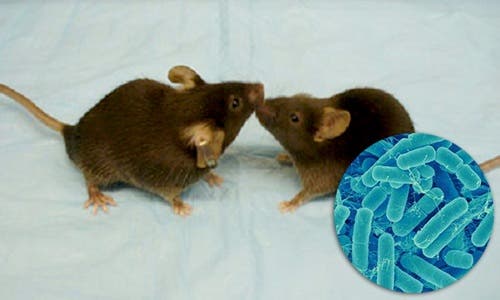We know that things like eye or skin colour are encoded in our DNA and passed down by our parents, but many other traits are significantly influenced by another hereditary mechanism: bacterial offspring. A paper in Nature suggests microbes are passed down from mother mice to pups, passing down traits similarly to how genes influence illness and health.
Bacteria offspring
Bacteria is often portrait as harmful, causing infections and disease. However, most of the bacteria present in our bodies, mostly the gut, are harmless or actually beneficial. Commensal bacteria can influence traits such as weight and behaviour (ZME Science reported a while ago how bacteria can ‘make’ you want to eat certain foods), but until now the general consensus was that the bacteria is acquired, not inherited.
“We have kept bacteria on one side of a line separating the factors that shape our development – the environmental side of that line, not the genetic side,” said co-senior author Herbert W. Virgin IV “But our results show bacteria stepping over the line. This suggests we may need to substantially expand our thinking about their contributions, and perhaps the contributions of other microorganisms, to genetics and heredity.”
This may serve to explain some of the problems labs have faced all over the world. Scientists working with lab mice for instance might find their pets express new and sudden traits, which can’t be explained by genetic variance alone. Obviously, the traits often spread from one mouse habitat to the next, but since these can spread to offspring it goes to explain a lot. Virgin and Thaddeus Stappenbeck of the Washington University School of Medicine also came across similar trouble while studying inflammatory bowel diseases, such as Crohn’s disease and ulcerative colitis. They found that more than half their mice had low levels of an antibody called IgA which is linked with bowel disease.
[SEE] How bacteria colonize the human gut
IgA helps defend the body against harmful invaders. It is commonly present in mucus made by the body in areas where the exterior world encounters the body’s interior, such as the eyes, nose, throat and gut.
Virgin and Stappenbeck placed mice which had low levels of IgA in the same pens with those with higher levels of IgA. Within a few weeks, all of the mice ended up having low levels of the antibody. When they bred the mice, the offspring whose mothers had low levels of the antibody also had low levels.
Eventually, they identified the likely culprit – a bacterium called Sutterella. The authors describe how the low IgA-mice can be explained through two mechanism: common bacterial transmission and offspring transmission. Mice that were housed together acquired low antibody levels through normal spread of the bacteria, and mouse mothers passed the same bacteria to their descendants.
This latter point is of important consequence, since it suggests bacterial traits can be passed to offspring in the same manner genetic ones do.
“The implications for mouse experiments are profound and could help us cut through some persistent sources of confusion,” Stappenbeck said. “When we study mice, we have to account for the possibility that inherited bacteria and their genes could be influencing the trait we’re trying to learn about.”










